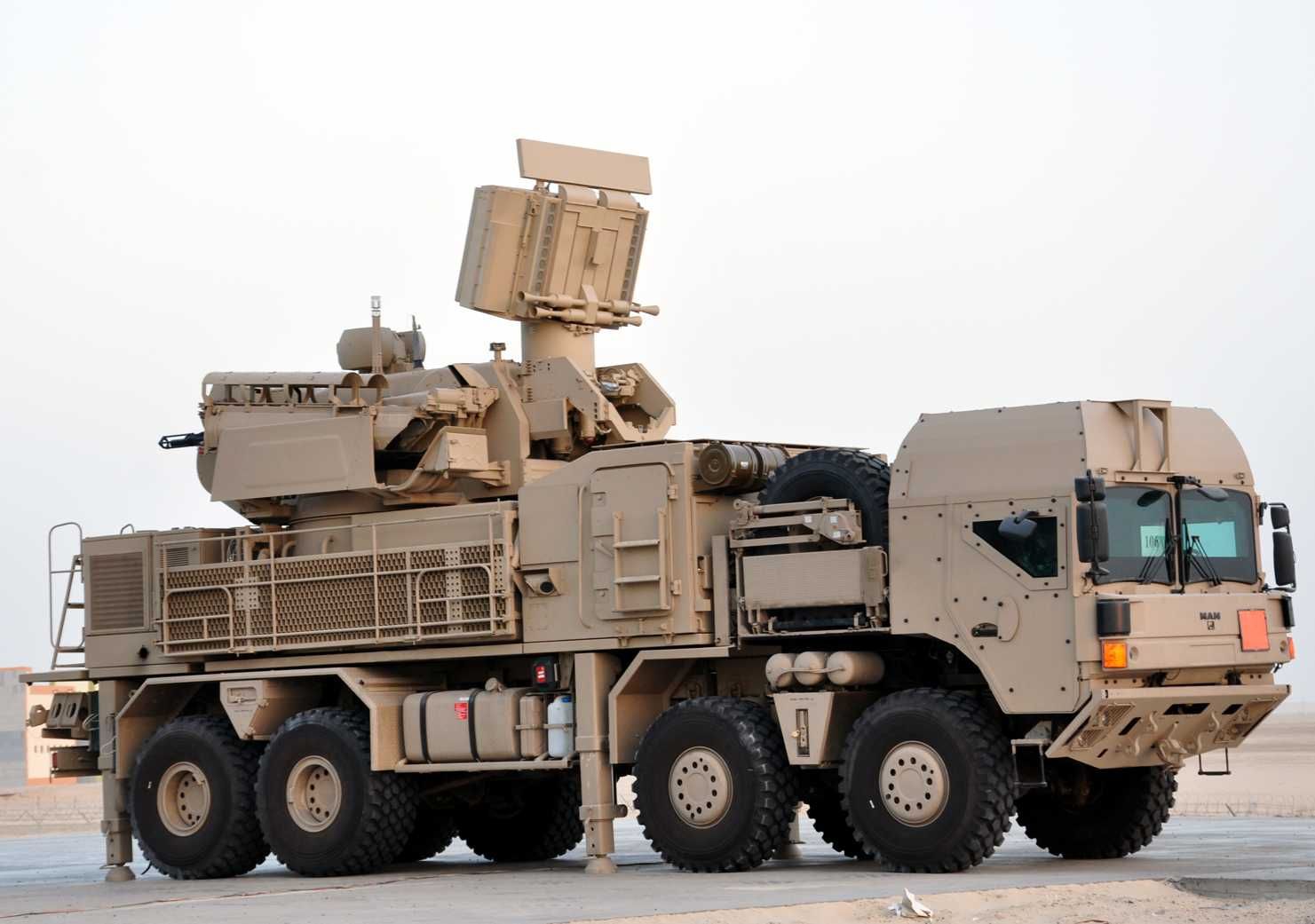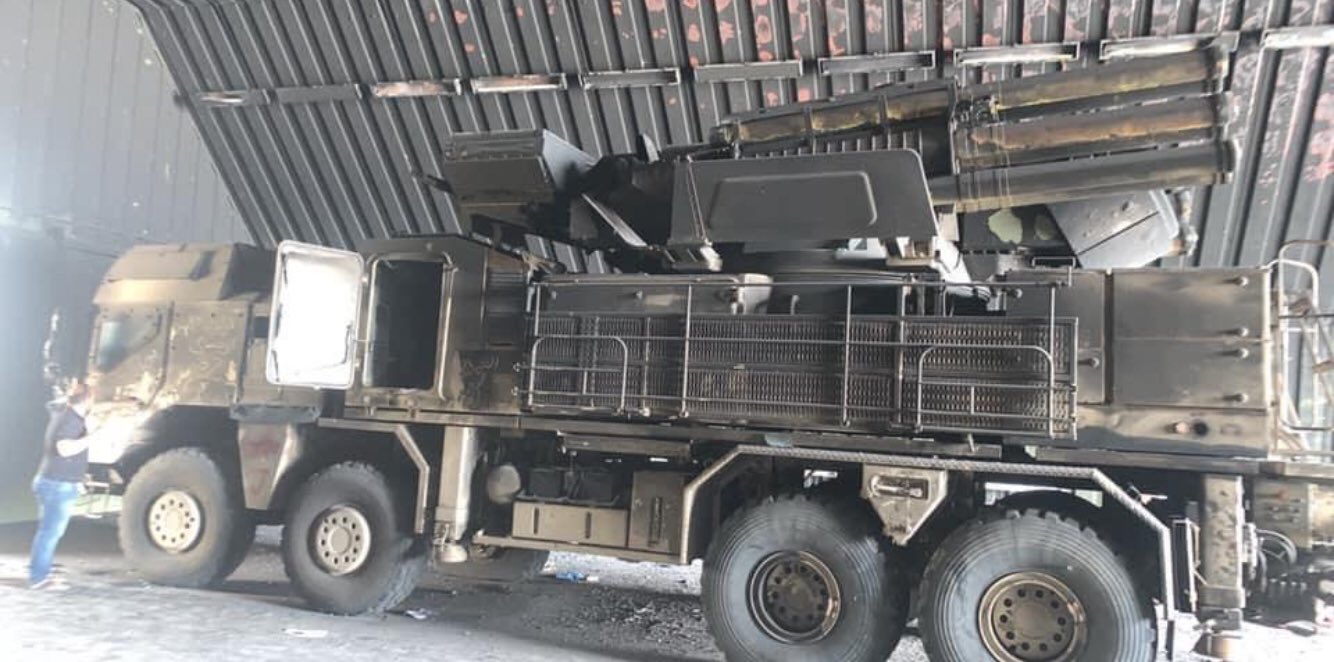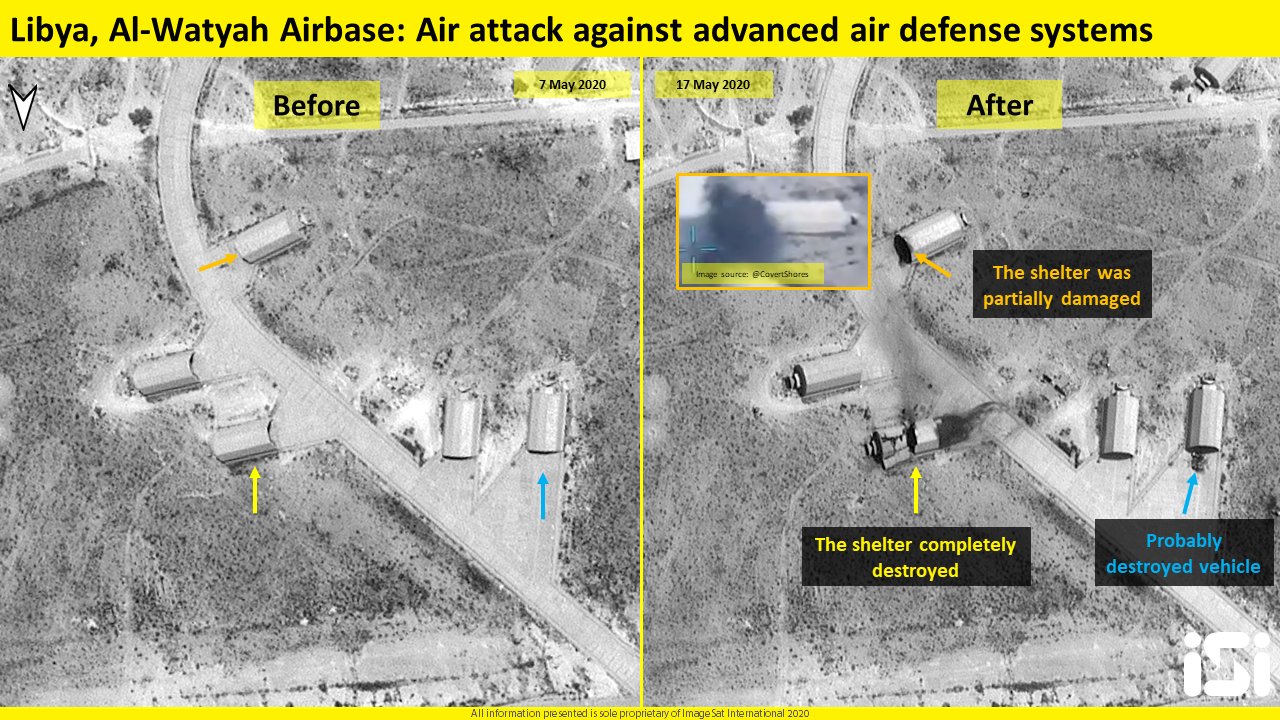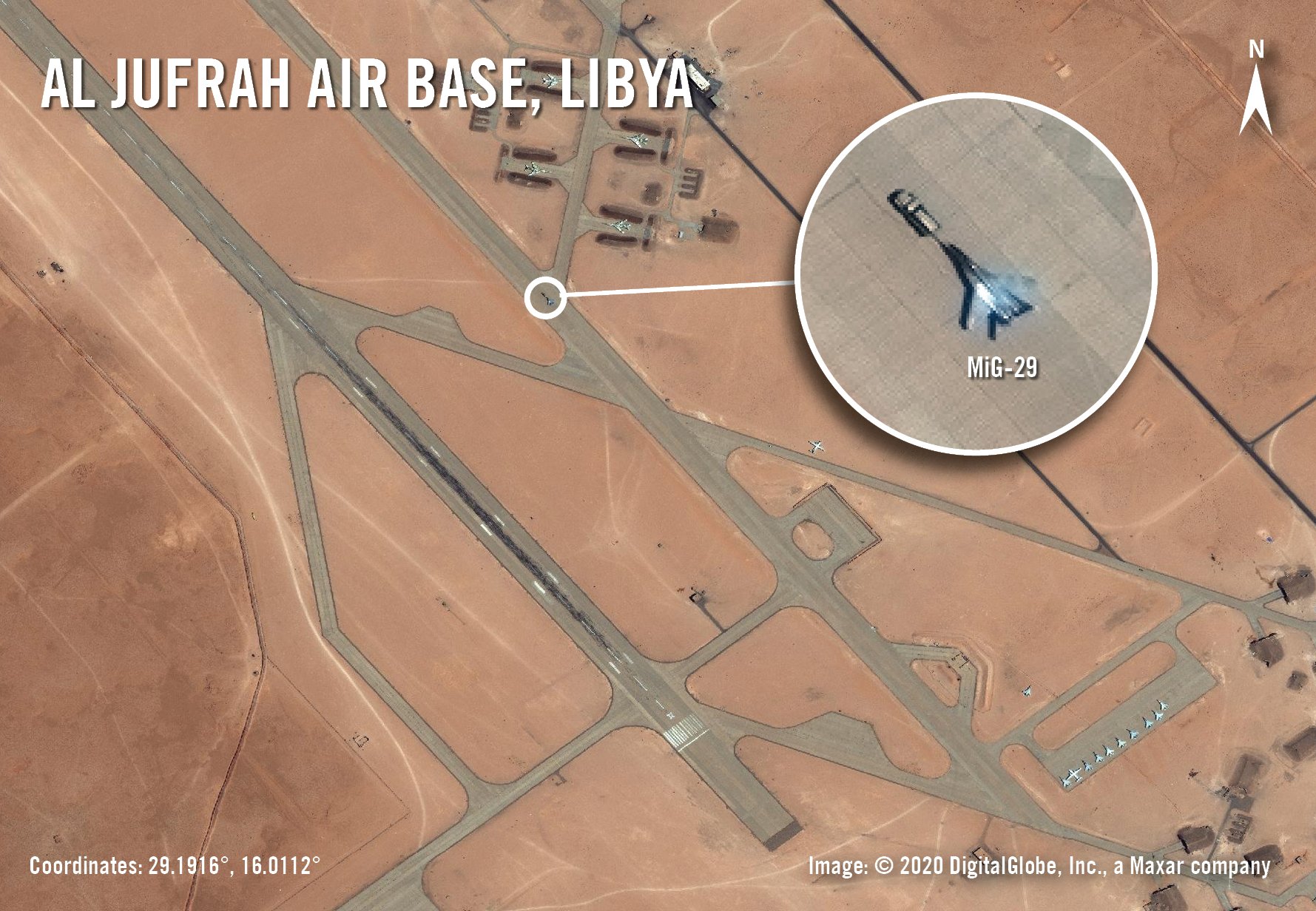Turkish drones operating in Libya on behalf of the Government of National Accord (GNA) have neutralized ten of General Haftar’s Pantsir S-1E (NATO Reporting name: SA-22 “Greyhound) air defense systems in less than a week. The Turkish aerial onslaught was the most significant suppression/ destruction of air defenses (S/DEAD) operation of the Libyan Civil War and a colossal humiliation for Russia’s prime counter-drone and short-range air defense. Forced into retreat, Haftar’s self-styled Libyan National Army (LNA) has pledged to respond with the biggest aerial battle in Libyan history.
OPERATION “VOLCANO OF RAGE”
The GNA’s counter-offensive against LNA advances in western Libya and around Tripoli (“Vulcano of Rage”), which commenced in April 2019, has finally reached a breakthrough. Backed by Turkey’s S/DEAD campaign, GNA forces have secured the Tunisian border, recaptured the western shoreline, and pushed the LNA out of its strategic positions in Watiyah Air Base and south of Gharyan. GNA militias are now ready to retake northwestern Libya (Tripolitania), the country’s most populous region.

Map of “Rage of Volcano” offensive via Rr016
BAYRAKTAR VS. PANTSIR
Pantsirs provide point air defense for LNA tactical positions, and especially airfields. The airfields are vital for Haftar’s air wing as they host fighter aircraft refurbished with Egyptian, Emirati, and Russian assistance, as well as Emirati drones for airstrikes against the GNA.

Emirati variant of the Pantsir S-1Export, which uses the Rheinmetal Man SX45 8×8 truck, via Portal Defensa
The Pantsir’s 96K6 surface-to-air missiles have an engagement range of up to 24 km. In comparison, Ankara’s Bayraktar 2TB unmanned combat aerial vehicle (UCAV), which was likely responsible for the strikes against Hafter, uses MAM-L Smart Micro Munition manufactured by Rokestan. The MAM-L can strike targets up to 14 km away. In theory, the Turkish UCAVs with their small warhead (max. 22 kg) and limited engagement range are not ideal for S/DEAD missions. Turkey likely leveraged the inexperience of the Pantsir crew members, who are a combination of Russian mercenaries (Wagner) and poorly trained Libyans (it is unknown whether the Emirati military advisors play an active role in operating the Pantsirs).

Bayraktar TB-2 armed with MAM-L and MAC-C missiles via IslamicWorldNews
Part of Turkey’s tactics are long-endurance ISR sorties (Intelligence, Surveillance and Reconnaissance) that identify the perfect window of opportunity for a strike. The footage in the BDA section shows that most of the attacks caught the Pantsirs unprepared and inactive after the Turkish drones had stalked them for an extended time.
It is furthermore possible that Turkey used the Koral Electronic Warfare (EW) system to jam, deceive or paralyze the Pantsir’s radar. An electronic attack could explain how the drones managed to get within firing range even when the air defenses were up and running. Turkey deployed the Koral in Libya as part of a broader military assistance package, which includes frigates, air defenses, and even Syrian rebels, in early 2020.

The KORAL Mobile Radar Electronic Warfare System is composed of Electronic Support and Electronic Attack System each mounted on an eight by eight tactical truck (photo credits: ASELSAN)
THE HUNT: BATTLE DAMAGE ASSESSMENT
The GNA claims that the drone campaign neutralized ten Pantsir S-1E air defense systems (9 destroyed, one captured) in four days, between 16 and 20 May.
The GNA and affiliated press outlets released footage that confirms seven drone strikes, most of which have been validated through geolocation. Analysis of the footage, coupled with social media photos from the target sites, irrefutably prove that the raids hit five Pantsir batteries – four destroyed, one damaged. However, this does not mean that the rest of the strikes did not take place or that other missiles did not reach their targets. It is uncommon for militaries to publish targeting footage from all of their operations.
We estimate that the loss of Pantsirs racks up a bill of at least $140 million for the United Arab Emirates, which supplied the systems to Haftar.
16-18 MAY: RAID ON WATIYA AIR BASE
The GNA resumed its counter-offensive against the LNA in early May, pledging to recover Haftar’s gains from the past year. On 15 May, GNA forces encircled the LNA-held Watiya Air Base (WAB) in western Libya and called in Turkish air support to soften the enemy’s defenses. On the night of 16 May, Turkish drones took to the skies of Watiya and raided the strategic airbase. The drones struck two clamshell hardened aircraft shelters (HAS) in WAB’s southeast corner, damaging a Pantsir S-1E. The GNA captured the Pantsir (and a makeshift user manual) after the LNA withdrew from WAB on 20 May.

The Pantsir S-1E system damaged after the drone raid on al-Watiya Air Base
The next day, Turkish drones bombed a third hangar, causing it to collapse on a Pantsir. Photos from the site show the Pantsir buried in concrete, seemingly totaled. This attack raised many questions, as the micro-munitions used by Turkish drones, do not pack a punch big enough to crumble a HAS. Possibly, a Turkish frigate off the Libyan coast launched a cruise missile that destroyed the “clamshell.” Alternatively, the drone attack triggered a series of secondary explosions, which caused the hangar to implode.
#عملية_بركان_الغضب: مشاهد لاستهداف منظومتي الدفاع الجوي الروسية بانتسير بعد ساعات من وصولها داخل قاعدة الوطية الجوية pic.twitter.com/hQ79ZwliJQ
— المركز الاعلامي لعملية بركان الغضب (@BurkanLy) May 17, 2020

BDA of the Al-Watiyah raids via ImageSat International
Left without anti-air cover and surrounded by the GNA, Haftar’s LNA withdrew from WAB on 18 May 2020. GNA militias secured the airbase immediately after. Social media postings of GNA fighters provide an on-site Battle Damage Assessment (BDA), which confirmes that one Patnsir was damaged and another destroyed (third hangar).

The second Pantsir S-1 targeted, covered in concrete
The photos also showcased other military hardware left behind by the LNA, including several decommissioned Mirage-F1 and Su-22 (Fitter) aircraft and Mi-24 (Hind) and Mi-35 helicopters (Hind-E) dating back to the Gaddafi-era.
18 MAY: SOUTH OF SIRTE
Hours before the LNA withdrew from WAB and some 300 km east, a Turkish drone executed another operation. The UCAV was monitoring an LNA military transport carrying an inactive Pantsir S-1 on its trailer. The truck was moving the Pantsir from Ghardabiya AB, near Sirte, to al-Jafra AB in central Libya. When the vehicle stopped around 70 km south of Sirte, the Turkish drone scored a direct hit on the Pantsir.
#Libya– ICYMI:
A photo purportedly showing one of the Pantsir S-1/SA-22 Greyhound that was destroyed near #Sirte on a KAMAZ-6560 8×8 truck chassis instead of the MAN SX 45 8×8 configuration (which is the model associated with the #UAE and all ones seen so far in country). pic.twitter.com/zNfjU5eD9y— Oded Berkowitz (@Oded121351) May 21, 2020
20 MAY: RAIDS ON TARHUNAH AND ELSEWHERE
Videos released to the press on 20 May, show a series of drone strikes that neutralized four Pantsirs in the town of Tarnurah. The airstrikes intended to soften Haftar’s defenses in the area.
مشاهد حصرية للأحرار تظهر استهداف منظومتي دفاع جوي نوع “بانتسير-S1” روسية الصنع في #ترهونة من قبل الجيش الليبي pic.twitter.com/1bDxoI8D04
— Libya Alahrar TV – قناة ليبيا الأحرار (@libyaalahrartv) May 20, 2020
The attack destroyed one inactive Pantsir, which was on the move in an intersection west of Tanurah. Two other Pantsirs were supposedly destroyed while sheltered in hangars. The videos show the missiles hitting the structures, but do not offer proof that confirms the “kills.” However, if the hangars were harboring Pantsirs, the air defense systems likely did not survive the attack.
#Libya-video of UAV footage purportedly showing another strike against an #LNA Pantsir S-1/SA-22 Greyhound in #Tarhuna, the #LNA last remaining strategic stronghold near #Tripoli
It’s important to highlight that the system (or indications of it) are *not* visible in the footage pic.twitter.com/AYt7LoUsNn
— Oded Berkowitz (@Oded121351) May 20, 2020
The fourth engagement shows an irrefutable kill of an active Pantsir – radar spinning and scanning. The official release claims that this strike also took place near Tarnurah.
The GNA Air Forces’ UAVs had destroyed a Russian made Pantsir S-1 (SA-22) supplied by the UAE to Haftar in Tarhuna while its tracking radar active. pic.twitter.com/Y8WEmArl6A
— Clash Report (@clashreport) May 20, 2020
The GNA also announced that it destroyed three other Pantsirs on the same day: two in “Wishka” and one in Suk el-Ahad. As they did not provide visual proof, we are unable to confirm the outcome or the location of the strikes.
HAFTAR TO STRIKE BACK?
The chief of the LNA’s air wing, Saqr Al-Jaroushi, vowed to unleash the “largest aerial campaign in Libyan history” with all Turkish positions now “legitimate targets for our airforce.”
The GNA’s Minister of Interior Fathi Bashagha said at least six MiG-29s (Fulcrum) and two Su-24s (Fencer) have flown into eastern Libya from Russia’s 55th Hmeimim Airbase in Syria, to bolster the LNA’s offensive capabilities. He added that Russian Air Force Su-35 air superiority fighters (Flanker-E) escorted the flight group.
Mr. Bashagha’s accusations are consistent with unconfirmed reports from earlier this week, which claimed that six MiG-29s flew from Russia to Syria with a stop in Iran’s Hamadan Air Base. This formation may have continued to Libya.
However, Scramble Magazine claims that the fighters jets were sent from Belarus, and not Russia. The aviation magazine assesses that the UAE procured MiG-29BM (Bolyshaya Modernizaciya) and Su-24M variants from the Belarussian Air Force for the LNA. They also said that Belarussian and Syrian pilots familiar with the airframes are likely involved in the operation.
Geospatial intelligence (GEOINT) released by Maxar Technologies partially confirmes the reports. Satellite imagery of the LNA-held al-Jufra Air Base (JAB) shows at least one MiG-29 taxied on the runway as of 19 May.

MiG-29 at al-Jufrah Air Base, Libya, on 19 May, via Digital Globe/ Maxar
Likely, JAB was also the destination of the Pantsir S-1E intercepted on the move south of Sirte on 18 May. It is possible that the Pantsir had been re-deployed to reinforce JAB’s aerial defenses before the aircraft build-up.
Haftar’s aerial reinforcements signal that the Libyan Civil War will likely re-escalate. It remains to be seen how the GNA’s main allies, Turkey, Qatar, and Italy, will react.
Founder of T-Intelligence. OSINT analyst & instructor, with experience in defense intelligence (private sector), armed conflicts, and geopolitical flashpoints.





